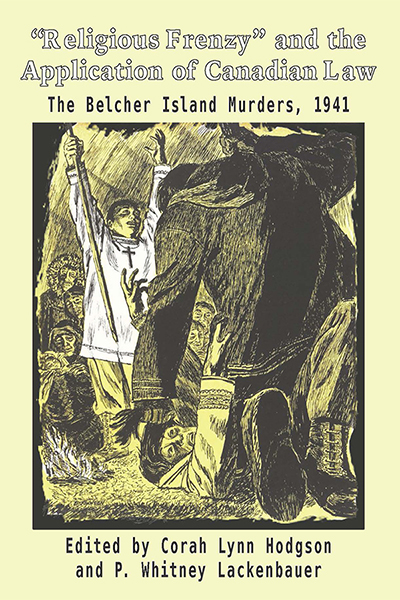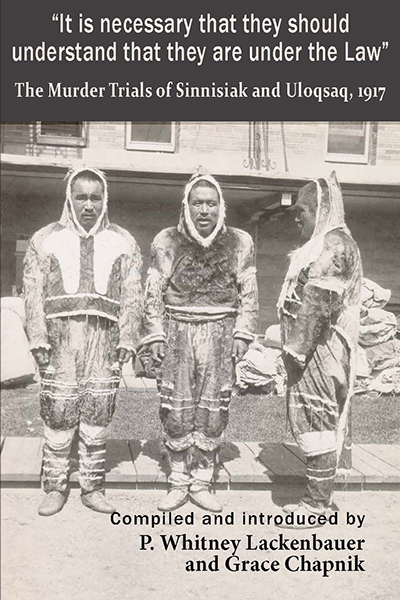Phase One: The Introduction of Colonial Law in Inuit Nunangat
The initial focus is on murder cases from the first half of the twentieth century, with particular attention devoted to Inuit Nunangat. These proceedings offer fascinating insights into how Northern Indigenous peoples administered justice, cross-cultural expectations and relations, and the government’s perceived need to enforce criminal law as an assertion of sovereignty.
The first volume, on the trials and subsequent executions of Tatamigana and his young nephew Alikomiak for the murders of RCMP Cpl. W. A. Doak and trader Otto Binder in 1922 at Tree River, was published in 2017 as Arctic Show Trial: The Trial of Alikomiak and Tatamigana, compiled by P. Whitney Lackenbauer and Kristopher Kinsinger, and introduced by Ken Coates and William R. Morrison. Alikomiak and Tatamigana were the first Inuit tried and executed for murder under Canadian law. The case was the third in a series of killings of outsiders by Inuit in the western Arctic which had begun in 1912; the first two (the subject of future volumes listed below) had resulted in more lenient treatment. The trial of these two men, which took place in the summer of 1923, was in the nature of a show trial, designed by the federal government to show the Inuit that the authorities would no longer tolerate such acts of violence. It was also meant to be a demonstration to the world of Canada’s sovereign rights in the Arctic, rights which had an uncertain foundation in international law. The conviction and execution of Alikomiak and Tatamigana caused controversy at the time; sentiment for clemency was based on claims (made then and subsequently) that Inuit were simple and primitive, and did not understand the principle of execution for murder. The sentencing of Alikomiak and Tatamigana was entirely in keeping with Inuit custom. Furthermore, alternatives to execution suggested by those with better knowledge of the North were in some ways even harsher than capital punishment. Extracts from the capital case file and the transcripts of the trial make these points clear.
The second volume, “Religious Frenzy” and the Application of Canadian Law: The Belcher Island Murders, 1941, by P. Whitney Lackenbauer and Corah Hodgson was released publicly in fall 2020. Supplemental parts to this volume provide additional material on the post-trial fate of the various Inuit convicted as well as additional archival records from the RCMP files shared by historian Kenn Harper. The Belcher Islands murders of 1941, and the official archival records related to them, provide a lens through which to illuminate and examine various aspects of the religious, legal, and political history of the Canadian North. The religious context of the murders provides insight into the strategies and techniques by which the Anglican missionary enterprise sought to convert Inuit, and the syncretic movements these strategies and techniques enabled among Inuit communities. The investigation of the murders, and subsequent coroner’s inquests, preliminary hearings, trials, convictions, and sentences, also allow an examination into the unique nature of police investigations and judicial proceedings in the Canadian North during this period. They provide insight into the government’s concerns about the suitability of applying British-Canadian punishments to the Inuit, without due consideration of their values or distinct customs. Politically, the federal government’s enduring emphasis on returning these Inuit to the North and their traditional hunting-trapping economies testifies to what scholars have called the government’s “policy of dispersal.” Hence, the events on the Belcher Islands in 1941 reveal more than simply the crimes committed by individual Inuit.
The third volume, “It is necessary that they should understand that they are under the Law”: The Murder Trials of Sinnisiak and Uloqsak, 1917, by P. Whitney Lackenbauer and Grace Chapnik was released in 2023. In October 1913, the Roman Catholic missionary priests Guillaume Le Roux and Jean-Baptiste Rouvière were killed by their Inuit guides Sinnisiak and Uloqsaq (Uluksuk) near Bloody Falls in the Kitikmeot region of what is now Nunavut. The Royal North West Mounted Police responded to stories of the priests’ fate, dispatching patrols to investigate in 1915, locating and arresting Sinnisiak and Uloqsaq in 1916, and bringing the Inuuk south for trial in 1917. The jury at the first trial in Edmonton for the murder of Father Rouvière acquitted Sinnisiak and Uloqsaq. A later trial in Calgary for the murder of Father Le Roux yielded a conviction for murder – and a commuted sentence of life imprisonment for which the Inuuk served two years before returning to their homes. This collection brings together primary documents related to the investigations and landmark trials, providing first-hand insights into early encounters between Inuit and the Canadian justice system.
The fourth volume, by P. Whitney Lackenbauer and Alicia Carefoote, will compile the police reports, court records, and newspaper articles related to the murders of Henry Radford and George Street at Bathurst Inlet in 1911.
The fifth volume, by Deborah Kigjugalik Webster, will reproduce the transcripts of the two trials of Kikkik in 1958.
The sixth volume will compile the police reports, court records, and newspaper articles related to the murder of Robert Janes in 1923 near Cape Crawford and the subsequent trial of Nuqallaq.
Anyone interested in contributing a volume to this series should please contact P. Whitney Lackenbauer at pwhitneylackenbauer@trentu.ca.
Other planned volumes include:
- The “million dollar duck”: the Sikyea case (1964)
- Clyde River v (2017)
- Drybones (1968)
- Eskimo case (1929)
- Paulette (1973)
- Sigeareak El-53 v. The Queen, [1966] S.C.R. 645
Subsequent Phases
To develop a more balanced and accurate understanding of the past, scholars from all backgrounds must engage with Indigenous ways of knowing and remembering the past, alongside more traditional archival methodologies. In the future, we hope to build an online platform that will invite and share commentaries by Northern legal experts, scholars, and other knowledge holders to offer their perspectives on the cases and the documents.




